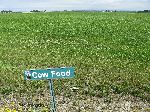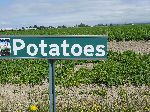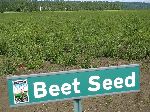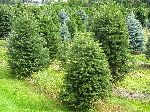Ibike
USA/Canada Program
Rolling the Islands of the Salish Sea
Photo essay: Rolling the Islands of the Salish Sea: Swinomish
Pt. Townsend to SWINOMISH (70km, 43mi) This area was the
rich hunting & fishing grounds of the Skagit / Swinomish People.
Points of
interest: Olympic rain shadow, a variety of coastlines, Deception Pass,
Swinomish Maiden story pole, Swinomish Native Sovereign Nation; Health Center, Senior
Center, Day Care, Smokehouse, Environment protection programs, cultural
programs, planning department. .
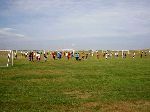
Summer soccer camp, Ft Casey
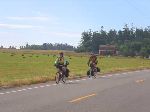
Bicycling along Ebey's Prairie
 Columbia, seeking
face-saving revenge for an earlier defeat and the killing of one of their chiefs in
the Battle of Pt Gamble by the cannons of the USS Massachusetts, raided Whidbey Is.
They pre-selected Ebey as their victim. They awakened him at his farmhouse, shot
and decapitated him, and fled back to the Queen Charlotte Islands with his head.
Several years later the grisly trophy was recovered by the Hudson's Bay Co. and
returned for burial with his body.
Columbia, seeking
face-saving revenge for an earlier defeat and the killing of one of their chiefs in
the Battle of Pt Gamble by the cannons of the USS Massachusetts, raided Whidbey Is.
They pre-selected Ebey as their victim. They awakened him at his farmhouse, shot
and decapitated him, and fled back to the Queen Charlotte Islands with his head.
Several years later the grisly trophy was recovered by the Hudson's Bay Co. and
returned for burial with his body.
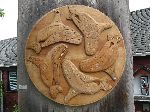 In
the late 19th and early 20th century many sea captain were drawn to the
sheltered, placid
waters of Penn Cove, on the eastside of Whidbey Is., and settled in Coupeville -- the inference being they were
tired of stormy sea? Now-a-days it is mostly tourists that are drawn to
its retro streetscape of art studios, crafts boutiques, public art and unique
eateries.
In
the late 19th and early 20th century many sea captain were drawn to the
sheltered, placid
waters of Penn Cove, on the eastside of Whidbey Is., and settled in Coupeville -- the inference being they were
tired of stormy sea? Now-a-days it is mostly tourists that are drawn to
its retro streetscape of art studios, crafts boutiques, public art and unique
eateries.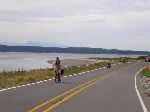
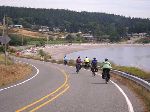
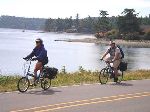 Penn
Cove is now know for its delectable mussels and scenic bicycling.
Traditionally, it was a prime shellfish gathering ground for the Swinomish,
Samish, Skagit and other local Native Americans people. It has the largest and
oldest shellfish farm in the country. It is also a great place to spot
bald eagles and osprey, in the right season.
Penn
Cove is now know for its delectable mussels and scenic bicycling.
Traditionally, it was a prime shellfish gathering ground for the Swinomish,
Samish, Skagit and other local Native Americans people. It has the largest and
oldest shellfish farm in the country. It is also a great place to spot
bald eagles and osprey, in the right season. 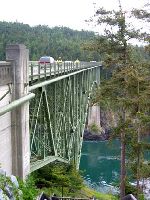
Deception Pass Bridge
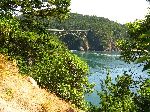 The Deception Pass Bridge
was originally envisioned by Capt George Morse in 1850. After more than
eighty years of procrastination, the very impressive bridge was built in one
year by the Works Progress Administration, opening in July 1935. The
surrounding state park of the same name was initially developed with the
manpower of the depression era Civilian Conservation Corps. The name
Deception Pass comes
from Captain Vancouver's realization that what he had mistaken for a peninsula
was actually an island.
The Deception Pass Bridge
was originally envisioned by Capt George Morse in 1850. After more than
eighty years of procrastination, the very impressive bridge was built in one
year by the Works Progress Administration, opening in July 1935. The
surrounding state park of the same name was initially developed with the
manpower of the depression era Civilian Conservation Corps. The name
Deception Pass comes
from Captain Vancouver's realization that what he had mistaken for a peninsula
was actually an island.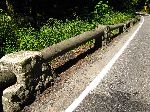
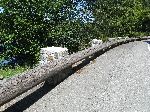 A
small detail around the bridge is the difference between the old guardrails (left, built by
the CCC) and new guardrails (right) along the highway. The old guard rails
are made with logs laid between stone and cement footings. The roadside
face is irregular. The newer guard rails are mounted out from the stone
and cement piers so that there is a smooth rub-rail.
A
small detail around the bridge is the difference between the old guardrails (left, built by
the CCC) and new guardrails (right) along the highway. The old guard rails
are made with logs laid between stone and cement footings. The roadside
face is irregular. The newer guard rails are mounted out from the stone
and cement piers so that there is a smooth rub-rail.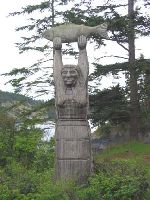


Swinomish member Ray Williams speaking
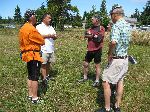 We have been
fortunate that Swinomish members have
generously presented informative, challenging and thought provoking
briefings on the revitalization of the Salish culture, social services programs
(health, education, legal, and seniors citizens) on the reservation, the message
of central totem pole, the symbolism of the carved posts in the longhouse, the
struggle between and the combining of traditional beliefs and Catholicism and
many other topics.
We have been
fortunate that Swinomish members have
generously presented informative, challenging and thought provoking
briefings on the revitalization of the Salish culture, social services programs
(health, education, legal, and seniors citizens) on the reservation, the message
of central totem pole, the symbolism of the carved posts in the longhouse, the
struggle between and the combining of traditional beliefs and Catholicism and
many other topics.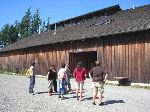
Swinomish Long House
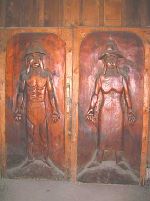 (salmon, roots, berries, wild meat, etc.) they needed for the winter seasons,
during the summer. There was not much to gather during the winter so it
became the time to spend in the long house developing and passing on the
cultural and spiritual knowledge. This was also the time of year that
people would go to other communities to visit and they would welcome visitors
into their own community and longhouse. Providing generous hospitality was
and is an import value of the Swinomish people. On the posts by the door
that visitors would use, are the eagle and salmon, both symbols for travel, to
welcome the visitors. The carving on each pole of the longhouse teaches something about the culture
or history.
(salmon, roots, berries, wild meat, etc.) they needed for the winter seasons,
during the summer. There was not much to gather during the winter so it
became the time to spend in the long house developing and passing on the
cultural and spiritual knowledge. This was also the time of year that
people would go to other communities to visit and they would welcome visitors
into their own community and longhouse. Providing generous hospitality was
and is an import value of the Swinomish people. On the posts by the door
that visitors would use, are the eagle and salmon, both symbols for travel, to
welcome the visitors. The carving on each pole of the longhouse teaches something about the culture
or history.
Carved door in the
Swinomish Longhouse
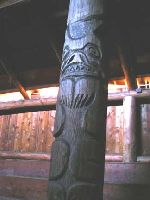
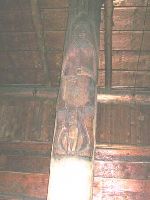
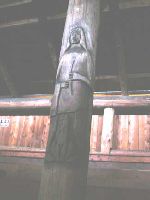
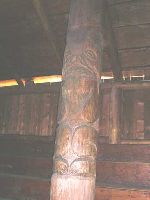
Carved poles in the Swinomish Longhouse
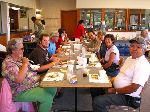

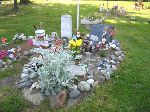 Swinomish cemetery.
It is more interesting than most because of the variety and extensiveness of the mementoes left at the graves,
and design of some of the grave monuments.
Swinomish cemetery.
It is more interesting than most because of the variety and extensiveness of the mementoes left at the graves,
and design of some of the grave monuments.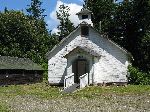
Old Shaker Church (1929), Swinomish WA [a new church was dedicated in 2011]
Version #2 of John Slocum's resurrection is: "In November of 1881, at 40 years of age, John Slocum operated a small logging camp on Skookum Inlet. He was killed in an accident in the woods and his two half brothers paddled to Olympia for a casket. But they had been gone only a few hours when the body began to stir. Eventually John sat up and began to speak. He claimed that God had sent him back to life with a message for the Indian people “ to believe in the man named Jesus."
A more extensive, Version #3 can be found on Wikipedia, https://en.wikipedia.org/wiki/John_Slocum
As it matured, the church incorporated elements of indigenous, catholic, and protestant religious practices (but not New England Shaker), and it’s early popularity naturally pissed off the tribes’ Euro-descended neighbors. Which, of course meant a ban and possible imprisonment of practitioners, new regulations, etc. Including this notice from the U.S. Indian Service:
It has been reported…that there are some women who are violating the Rules…and that they shake at all hours of the day and night. You will therefore tell the women quietly to stop shaking at any other times than the times specified in the rules…[Y]ou will lock them up until they agree to stop.
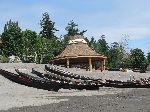
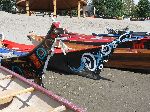
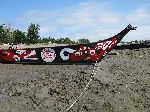
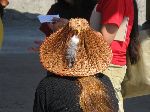
In August of 2011, the Swinomish hosted the annual Salish Sea Canoe Journey. Every year canoe teams from First Nations Peoples, from northern British Columbia, the Washington Coast, southern Puget Sound, and points in between, paddle to that years gather place for a week of camaraderie and culture. It can take distant groups several weeks of paddling to reach the celebration.
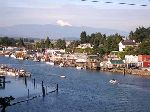
 La Conner started as a
Swinomish trading post, just off one of the deltas of the Skagit River. In 1867, renamed by John S Conner for his wife Louis
Anne Conner. In its current incarnation it has a lot of upscale galleries,
boutiques, gift shops, canal-side restaurant and antique stores.
La Conner started as a
Swinomish trading post, just off one of the deltas of the Skagit River. In 1867, renamed by John S Conner for his wife Louis
Anne Conner. In its current incarnation it has a lot of upscale galleries,
boutiques, gift shops, canal-side restaurant and antique stores.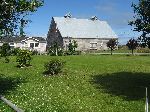
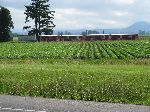
Farmhouse and barn (upper) and farm worker housing (lower)
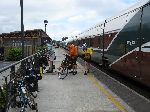
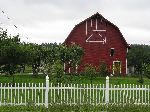
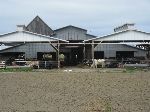
 If
you choose to bicycle back to Seattle, there is one more nice agricultural
valley, the Stillaguamish Valley, before for you meet nearly one-hundred
miles of urban and suburban sprawl the stretches from north of Everett (Smokey
Point), through Seattle, to south of Tacoma (Steilacoom). The
Stillaguamish Valley is a lovely bicycle ride, but similar esthetic routes south
from it are few and far between.
If
you choose to bicycle back to Seattle, there is one more nice agricultural
valley, the Stillaguamish Valley, before for you meet nearly one-hundred
miles of urban and suburban sprawl the stretches from north of Everett (Smokey
Point), through Seattle, to south of Tacoma (Steilacoom). The
Stillaguamish Valley is a lovely bicycle ride, but similar esthetic routes south
from it are few and far between.
 Please
contact us if you would like to be added to
Ibike's mailing list or have questions, comments, corrections or criticism. (Also, please let us know how you learned about us and
found this site.) Privacy policy.
Please
contact us if you would like to be added to
Ibike's mailing list or have questions, comments, corrections or criticism. (Also, please let us know how you learned about us and
found this site.) Privacy policy.
![]() IBF Homepage
IBF Homepage ![]() Ibike Programs
Ibike Programs
![]() Ibike Schedule
Ibike Schedule
![]() Search
Search


